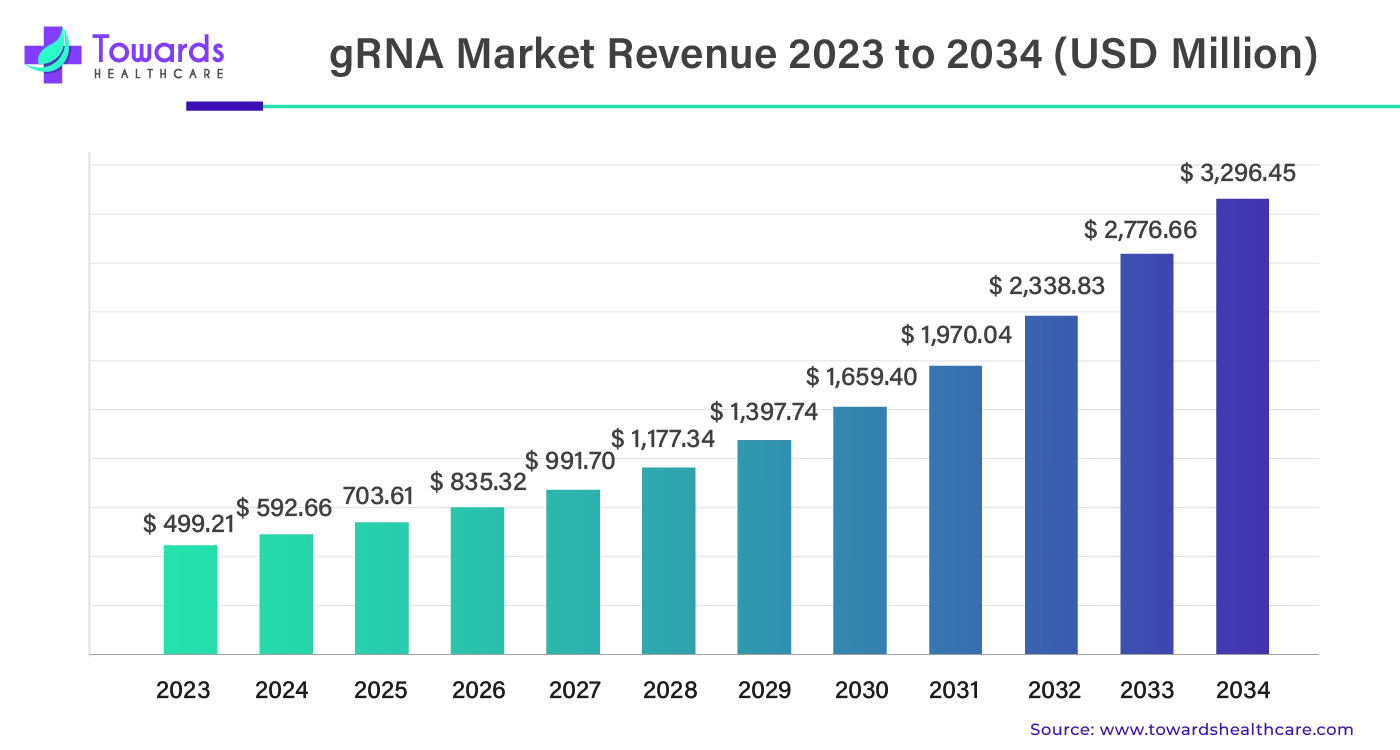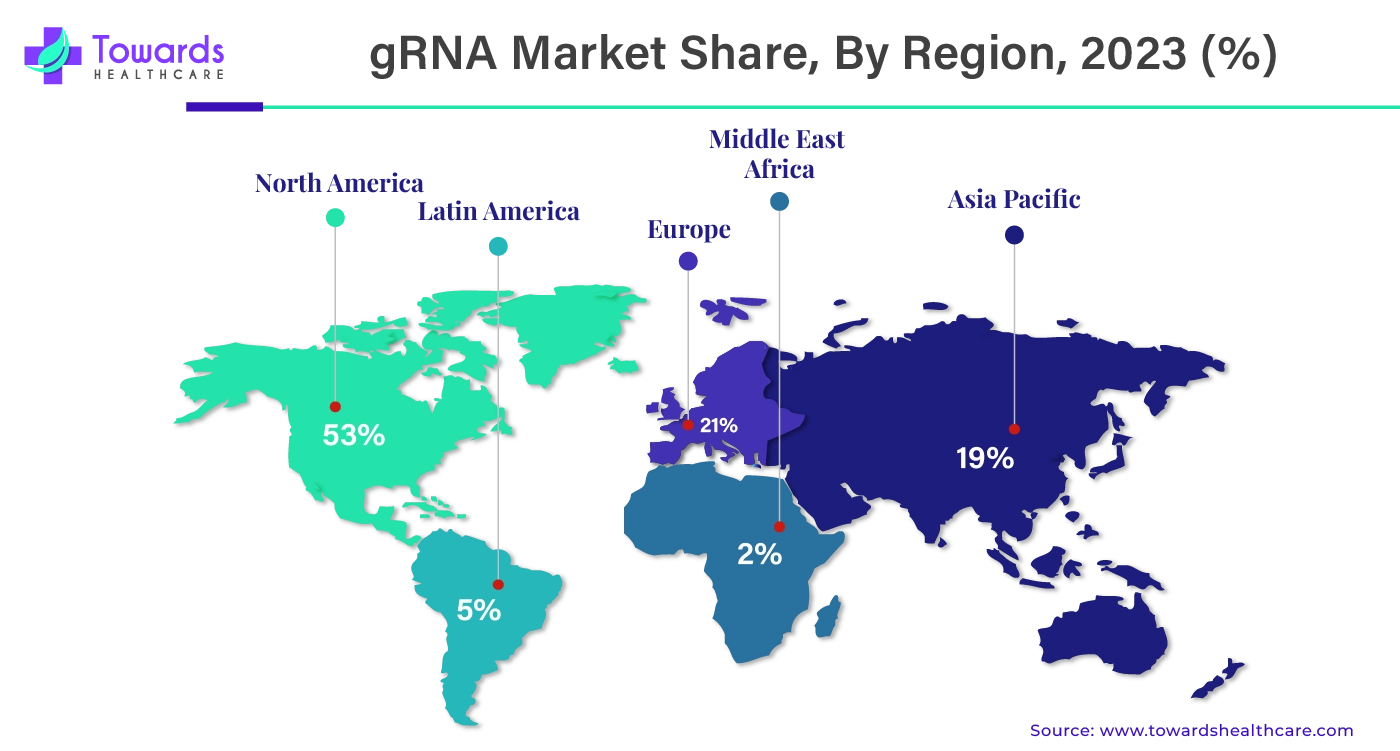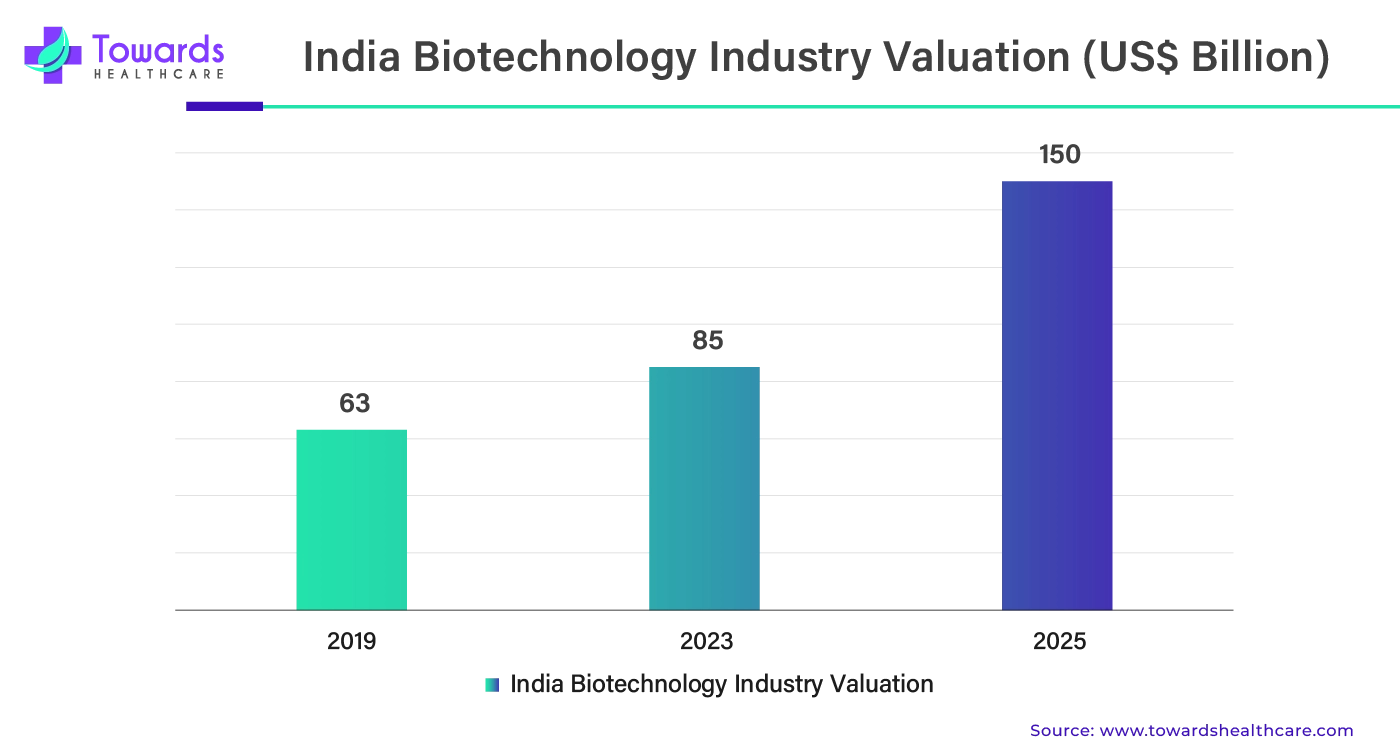January 2025

The global gRNA market was estimated at US$ 499.21 million in 2023 and is projected to grow to US$ 3,296.45 million by 2034, rising at a compound annual growth rate (CAGR) of 18.72% from 2024 to 2034. Growing research in genomics due to rare diseases and gene and cell therapy drives the use of gRNA.

Unlock Infinite Advantages: Subscribe to Annual Membership
Through base-pairing with the mRNAs in edited areas, guide RNAs, or gRNAs, are small RNA transcripts that direct the editing machinery. Using scaffold tracrRNA sequence fused with custom-made crRNA and template DNA, the gRNA may be created in vivo or in vitro. Together with other reagents, recombinant gRNA is used in laboratories to carry out a variety of assays, such as multiplex PCR, classic PCR, whole-genome sequencing, cloning, cell line development, primers, and recombinant plasmid DNA, as well as mismatch assays for mutagenesis, DNA modification, and gene expression research.
| Chemically-Modified sgRNA | In-vitro transcribed (IVT) sgRNA | Plasmid DNA | |
| Compatible Cell Types |
Stem Cells Primary Cells Cell Lines |
Cell Lines | Cell Lines |
| Preparation Steps | 3 | 5 | 5 |
| Preparation Time | Low | Medium | High |
| #Clones to Sort | Few | Many | Many |
| Editing Efficiency | Consistently high | Variable | Variable |
In order to treat disorders like Thalassemia and sickle cell anemia, genome editing may be done with more accuracy, economy, and efficiency with the use of artificial intelligence (AI). For CRISPR-Cas systems, guide RNAs (gRNAs) have been designed using AI models. Techniques like DeepCRISPR, CRISTA, and DeepHF are able to forecast the best guide RNAs (gRNAs) for a given target sequence. AI makes it possible to provide individualized therapies based on genetic profiles in conjunction with genome editing and precision medicine. AI examines genetic data from individuals to find biomarkers, mutations, and changes linked to conditions including diabetes, cancer, Alzheimer's, and other conditions.
For instance,
| Company Name | CRISPER QC |
| Headquarters | California, U.S., North America |
| Recent Development | In August 2024, CRISPR QC is thrilled to announce the release of a number of innovative technologies that will transform the gene editing industry. With the help of these CRISPR Analytics Platform solutions, researchers may improve their studies with unmatched precision as they offer thorough insights into different phases of CRISPR processes. With the help of this solution, CRISPR workflows may be precisely optimized by measuring gRNA design efficiency and RNP stability in real-time. |
| Company Name | Synthego |
| Headquarters | California, U.S., North America |
| Recent Development | In March 2024, the CRISPR guide RNA and engineered cell divisions of gene editing technology company Synthego were spun off into a separate company named EditCo Bio. Venture capital company Telegraph Hill Partners provided EditCo with an unknown sum of investment finance in conjunction with its debut. As per Synthego, EditCo's primary focus will be on creating and producing enhanced CRISPR-guided RNAs and modified cells for clients involved in gene therapy and cell biology research. |
Research on genome engineering has been considerably expedited by genomics advances led by the CRISPR-Cas9 technique. A rising number of researchers are utilizing CRISPR in their work since it opens up more and more uses every day. The swift ascent of CRISPR technology in genome engineering and related research fields has led to the demand for algorithms and corresponding web-based resources that streamline the creation of efficient and on-target guide RNAs (gRNAs). Choosing the appropriate guide RNA is essential to the outcome of your CRISPR research, and there are a number of crucial factors to consider.
The difficulties in expanding ex vivo cell treatments with genome editing are similar to those in other cell therapies. Depending on whether the treatments are allogeneic or autologous, these difficulties take different forms. Adding customization to autologous treatments is the main challenge since it adds unpredictability to both qualitative and quantitative parts of the procedure, including the number of cells extracted from each patient. Increasing the scope of allogeneic cell treatments poses several obstacles, mainly with scalability.
Through the combined techniques of guide RNA and Cas nuclease engineering, these systems have been modified from their native equivalents. More programmability and multiplexing capability are available with these RNA-guided methods than with previous-generation gene editing instruments. Precision medicine can become much more individualized with the use of CRISPR-Cas systems. Precision medicine refers to the customized clinical treatment of an illness. To do this, it is necessary to map synthetic lethal gene connections, identify therapeutic targets, and clarify each person's unique genotype.
By product & services, the products segment held the largest share of the gRNA market in 2023. Different materials are used for the production of gRNA, which include nucleotides, primers, plasmids, buffers, enzymes, templates, and so on. PCR is conducted in order to produce fragments of gRNA, which is further used in different applications.
A variety of materials, including nucleotides, primers, plasmids, buffers, enzymes, and templates, are used in the synthesis of gRNA. The effective synthesis of gRNA is facilitated by this wide range of components. Furthermore, PCR is essential for producing gRNA fragments, which are required for many different applications. Particular gRNA fragments are generated by the PCR process, opening the door for their use in several scientific and therapeutic applications. In the end, this methodical approach to gRNA manufacturing advances the fields of genetic research and biotechnology by guaranteeing the availability of a variety of resources and the use of advanced procedures.
By gRNA type, the research-use segment dominated the gRNA market in 2023. Researchers are attempting to establish design guidelines for CRISPRa and CRISPRi that take into account the amount and location of gRNAs in relation to particular identified properties of the target gene, in addition to the gRNA sequence. In actuality, scientists can employ a variety of instruments. For example, they might use one or more to generate a preliminary list of gRNA designs before choosing the ones that are most similar, or they could use one tool for design and another for assessing potential efficacy. Exciting new research opportunities in non-model species, as well as known model systems and cultivated cells, are presented by the ISPR-Cas9 technology.
By gRNA type, the GMP-grade segment is estimated to grow at the fastest CAGR in the gRNA market during the forecast period. All items used in clinical trials and those destined for the market must adhere to GMP regulations. sgRNAs for use in CRISPR-based therapeutic clinical trials include GMP-grade variants. FDA and EMA requirements for GMP materials for drug products are fully complied with by GMP-grade sgRNAs and the quality paperwork that goes along with them. GMP sgRNAs are a smooth transition from INDe and RUO sgRNA products, giving researchers a quick and easy way to move their potent medicines from the lab into the clinic.
By application, the genome engineering segment held the dominant share of the gRNA market in 2023. Targeted nucleases are effective agents for precisely mediating genomic modification. There is a huge potential for applications in fundamental research, medicine, and biotechnology when it comes to engineering biological systems and organisms. Recent years have seen the development of several genome editing methods, including the RNA-guided CRISPR-Cas nuclease system, transcription activator-like effector nucleases (TALENs), and zinc-finger nucleases (ZFNs). The nuclease Cas9 is an example of a system that is remarkably simple to develop, incredibly precise, extremely effective, and well-suited for multiplexed and high-throughput gene editing on a range of cell types and species.
For instance,
By end-use, the pharmaceutical & biotechnology companies segment held the largest share of the gRNA market in 2023. For both basic science and biotechnological applications, the CRISPR/Cas system has been shown to be the most effective and useful genome engineering technology available. The domains of genetics, synthetic biology, and functional genomics now have more opportunities thanks to the biotechnological uses of CRISPR-Cas. Medical research is looking at it in relation to cancer, HIV, and gene therapy conditions such as Duchenne muscular dystrophy, sickle cell disease, and cystic fibrosis.
For instance,
By end-use, the academic research institutes segment is anticipated to grow at the fastest rate in the gRNA market during 2023-2034. The most effective instrument available to universities for producing new or improved knowledge and promoting learning is academic research. The goal of academic research is to produce new information that advances societal growth. One of the primary duties of a faculty member employed by a school is conducting this study.

North America dominated the gRNA market share by 53% in 2023. Many things contribute to this leadership, such as the significant local presence of important companies like Merck KGaA and Thermo Fisher Scientific. These major firms also increased their expenditure in the region on research and development, which helped the gRNA sector thrive. In terms of market growth in North America, the United States leads the pack.
To gather feedback from the public, the NIH published a draft of its 2023–2028 data science strategic plan in December 2023. The gains from the first NIH Strategic Plan for Data Science are built upon in this revised plan, which will also equip NIH to handle the rapidly increasing volume and diversity of data as well as the accelerating advent of sophisticated new technology.
The Genomic Data Science Analysis, Visualization, and Informatics Lab-space (AnVIL)76 genomic data sharing and analysis platform of the National Human Genome Research Institute (NHGRI); All of Us77, which has gathered data from more than 500,000 participants; the NIH database of Genotypes and Phenotypes (dbGaP)78, which contains controlled access data, including sequence, genotype, and/or phenotype data from more than 3.2 million research participants; and other NIH-supported data platforms. The research community may access data and analytical tools, apps, and workflows in safe environments using these cloud-based data infrastructures.
By region, Asia Pacific is expected to grow at the fastest rate during the forecast period. The significant target population, quick technological adoption, biotechnology industry expansion, emergence of several startups, continuous market development of healthcare infrastructure, and the existence of significant unmet clinical requirements are the main causes of this rise. A number of initiatives have been implemented by the Chinese government to support the development of the biotech sector. These programs include reduced regulatory processes, tax incentives, and funding for research and development. As a result, these actions have drawn large investments into the region from both domestic and foreign businesses.
9 biotech parks were sponsored by DBT, whereas sixty bio-incubators were funded by BIRAC. The Department of Biotechnology (DBT) received US$ 271 million, or Rs. 2,251.52 crore, in the Interim Budget 2024–25. More than 150 NGOs and 30 MSMEs are among the 101 initiatives that the National Biopharma Mission is funding. In order to foster a robust ecosystem for information exchange, the National Biotechnology Development Strategy 2020–25 offers the government a framework for enhancing innovation, resource management, and talent development.

By Product & Services
By gRNA Type
By Application
By End-use
By Region
January 2025
December 2024
December 2024
December 2024